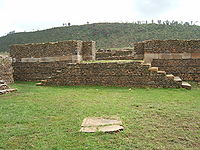
Dungur
Encyclopedia

Ethiopia
Ethiopia , officially known as the Federal Democratic Republic of Ethiopia, is a country located in the Horn of Africa. It is the second-most populous nation in Africa, with over 82 million inhabitants, and the tenth-largest by area, occupying 1,100,000 km2...
, the former capital of the Kingdom of Aksum. These ruins are located in the western part of Aksum, across the Gondar
Gondar
Gondar or Gonder is a city in Ethiopia, which was once the old imperial capital and capital of the historic Begemder Province. As a result, the old province of Begemder is sometimes referred to as Gondar...
road from the Gudit Stelae field.
Dungur is known locally and popularly as the Palace of the Queen of Sheba (i.e. the Palace of Makeda in Ethiopia). However, Stuart Munro-Hay describes it as "the sort of dwelling that a prosperous Aksumite, perhaps a noble or high official of the fourth to sixth centuries AD, might have constructed for himself."
Description
The remains of the mansion and its associated building are limited to the lowest levels and the podium, covering about 3,250 square meters. During its prime, a double staircase led into the entrance of the complex which opened into one of the courtyards surrounding the central structure.In the associated buildings a number of stone piers were recovered, "presumably for supporting wooden columns or floors", and brickwork which might be evidence of a hypocaust
Hypocaust
A hypocaust was an ancient Roman system of underfloor heating, used to heat houses with hot air. The word derives from the Ancient Greek hypo meaning "under" and caust-, meaning "burnt"...
. However, the purpose of these buildings is unclear. Munro-Hay notes, "The 'rooms' with stone piers have no doorways, and the piers presumably supported floors, but occasional divisions on the same level do have doorways, implying that not all the lower level was merely a podium for a higher floor level. Possibly some rooms were entered from within by ladders."
Archeology
S. Puglisi performed the first archeological excavation in this area, excavating a 3 x 5 meter sondage with the intent of revealing its stratificationStratification (archeology)
Stratification is a paramount and base concept in archaeology, especially in the course of excavation. It is largely based on the Law of Superposition...
. The next excavations in this area were conducted in 1966-8 by Francis Anfray, who uncovered a dwelling 250 meters west of Puglisi's trench that he described as a "château
Château
A château is a manor house or residence of the lord of the manor or a country house of nobility or gentry, with or without fortifications, originally—and still most frequently—in French-speaking regions...
", inhabited by one of the city's elite. Based on the evidence from these excavations, Butzer dated Anfray's dwelling to the seventh century; he pointed out that the masonry was similar to the base of St Mary of Zion church (which is part of the original structure that dated from Axumite times), while the floor plan was similar to the layout of the central block of the Ta'akha Maryam palace.

